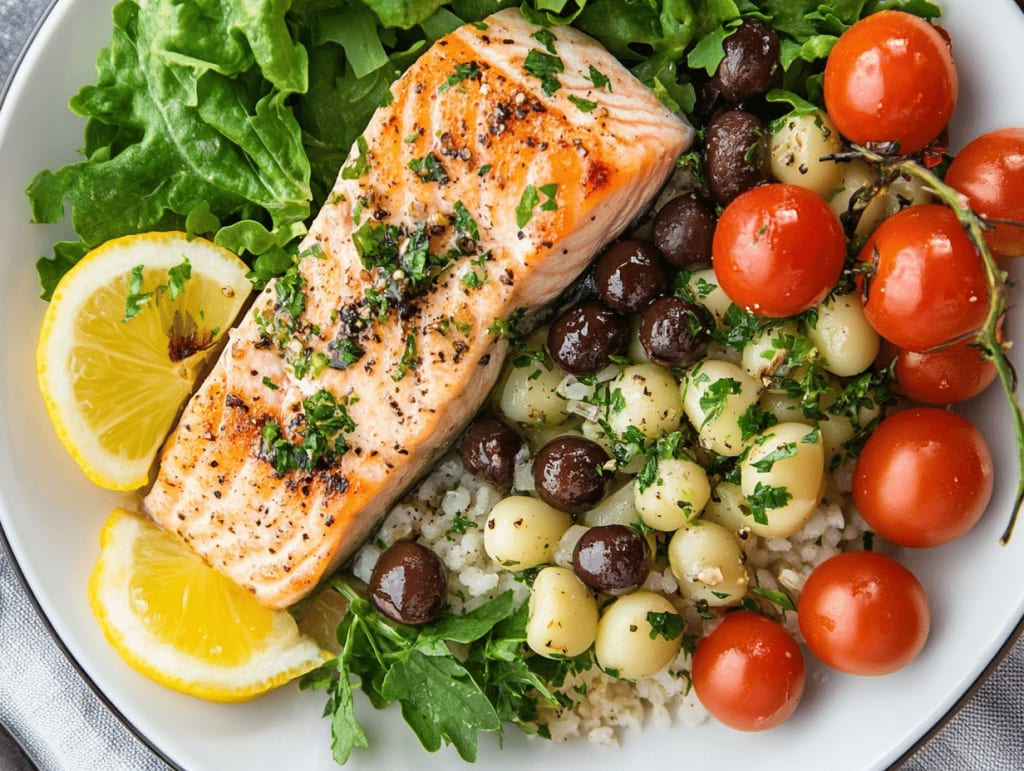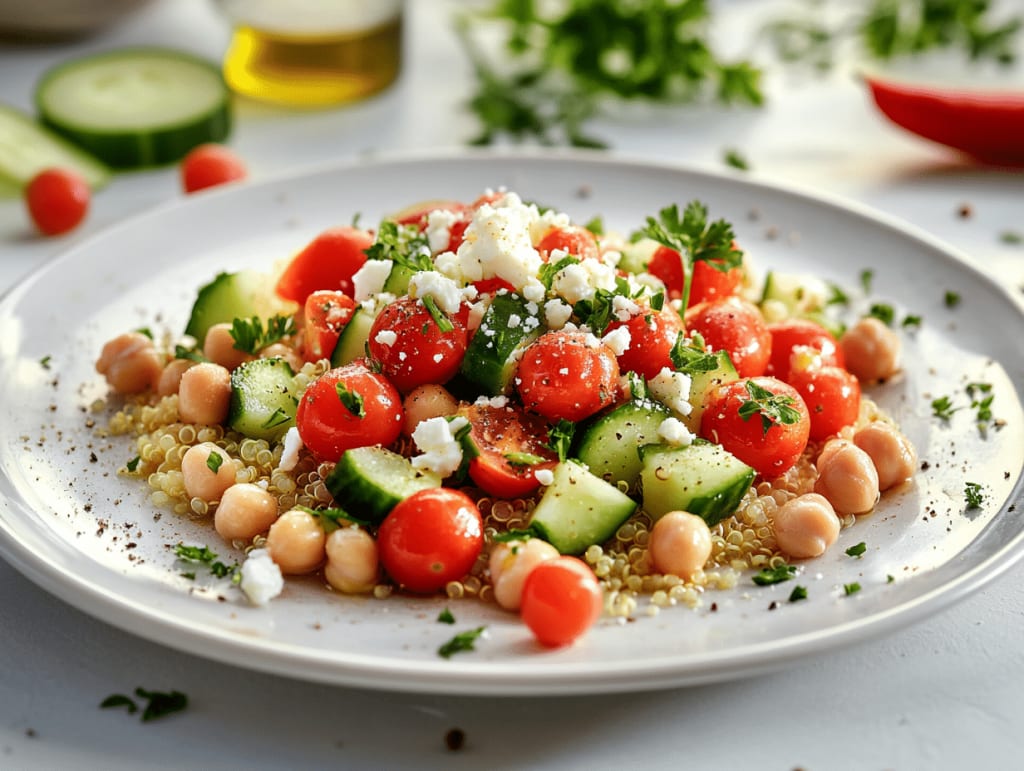Managing blood sugar levels doesn’t have to mean sacrificing flavor or satisfaction in your meals. As a registered dietitian specializing in metabolic health, I’ve designed this comprehensive 30-Day Mediterranean Diet Meal Plan for Better Blood Sugar to help you stabilize glucose levels while enjoying delicious, nutrient-dense foods that have sustained Mediterranean populations for centuries.
The Mediterranean diet stands as one of the most scientifically-backed eating patterns for improving insulin sensitivity and reducing the risk of type 2 diabetes. This carefully crafted meal plan combines the time-tested principles of Mediterranean eating with modern nutritional science to create a sustainable approach to blood sugar management that you can maintain long-term.
Why This Plan Works for Blood Sugar Management
The 30-Day Mediterranean Diet Meal Plan for Better Blood Sugar is built on four key nutritional pillars that work synergistically to promote stable glucose levels throughout the day.
The Science Behind Mediterranean Diet and Glycemic Control

The Mediterranean diet has been extensively studied for its cardiovascular and metabolic benefits. Research consistently shows that this eating pattern can improve insulin sensitivity by up to 23% and reduce hemoglobin A1C levels in people with diabetes and prediabetes.
What makes this approach so effective is its emphasis on:
High-Fiber Complex Carbohydrates: Unlike refined grains that cause blood sugar spikes, Mediterranean staples like steel-cut oats, quinoa, and legumes provide sustained energy release. These foods have a lower glycemic index, meaning they raise blood sugar more gradually.
Monounsaturated Fats from Olive Oil: Extra virgin olive oil contains compounds that improve insulin sensitivity and reduce inflammation. Studies show that replacing saturated fats with olive oil can improve glucose metabolism within weeks.
Lean Proteins and Omega-3 Rich Fish: Protein helps stabilize blood sugar by slowing carbohydrate absorption. Fish like salmon, sardines, and mackerel provide omega-3 fatty acids that reduce insulin resistance.
Antioxidant-Rich Vegetables and Fruits: Mediterranean produce is loaded with polyphenols and flavonoids that protect pancreatic beta cells and improve glucose uptake by muscles.
This 30-Day Mediterranean Diet Meal Plan for Better Blood Sugar strategically combines these elements in every meal to create a powerful blood sugar balancing effect that becomes more pronounced with consistent adherence.

Week 1: Foundation Building
Week one focuses on establishing healthy eating rhythms while introducing your body to Mediterranean flavors and nutrient timing patterns that support stable blood sugar.
Day 1
Breakfast: Greek yogurt parfait with 1/2 cup plain Greek yogurt, 1 tablespoon chopped walnuts, 1/4 cup fresh berries, and a drizzle of honey Lunch: Mediterranean chickpea salad with cucumber, tomatoes, red onion, parsley, lemon juice, and olive oil, served with 1 slice whole grain bread Dinner: Baked salmon with roasted vegetables (zucchini, bell peppers, red onion) seasoned with herbs and olive oil Snack: 10 olives with 1 small apple
Day 2
Breakfast: Vegetable omelet made with 2 eggs, spinach, tomatoes, and feta cheese, cooked in olive oil Lunch: Lentil soup with a side of mixed greens dressed with lemon vinaigrette Dinner: Grilled chicken breast with quinoa pilaf and steamed broccoli Snack: 1/4 cup hummus with sliced cucumber
Day 3
Breakfast: Steel-cut oatmeal topped with sliced almonds, cinnamon, and diced pear Lunch: Tuna salad made with olive oil (not mayo) served over mixed greens with cherry tomatoes Dinner: Mediterranean stuffed bell peppers filled with ground turkey, brown rice, tomatoes, and herbs Snack: 1 small handful of mixed nuts
Day 4
Breakfast: Whole grain toast with avocado, sliced tomato, and a sprinkle of za’atar seasoning Lunch: Greek salad with chickpeas, cucumber, tomatoes, olives, and feta cheese Dinner: Baked cod with herb-roasted potatoes and sautéed spinach Snack: 1 small orange with 6 almonds
Day 5
Breakfast: Smoothie made with Greek yogurt, spinach, berries, and a tablespoon of ground flaxseed.. Lunch: Quinoa tabbouleh with plenty of parsley, mint, tomatoes, and lemon dressing Dinner: Grilled lamb chops with roasted eggplant and a small portion of bulgur wheat. Snack: 2 tablespoons tahini with celery sticks
Day 6
Breakfast: Greek yogurt with chopped walnuts, a drizzle of olive oil, and fresh herbs (unusual but traditionally Mediterranean). Lunch: White bean and vegetable soup with a small piece of whole-grain bread. Dinner: Grilled sardines with roasted cherry tomatoes and quinoa. Snack: 1/4 cup olives with cucumber slices
Day 7
Breakfast: Vegetable frittata made with eggs, zucchini, onions, and fresh herbs. Lunch: Mediterranean wrap with hummus, grilled vegetables, and a small amount of whole wheat tortilla. Dinner: Baked chicken thighs with lemon, oregano, and roasted root vegetables. Snack: Fresh fruit salad with a sprinkle of chopped pistachios

Week 2: Expanding Variety and Meal Prep Strategies
Week two introduces more complex flavors while establishing meal prep routines that make following this 30-Day Mediterranean Diet Meal Plan for Better Blood Sugar more manageable for busy schedules.
Batch Cooking Tips for Week 2
Prepare large batches of staples on Sunday: cook 2 cups of quinoa, roast a sheet pan of mixed vegetables, and prepare a large pot of lentil or white bean soup. These components can be mixed and matched throughout the week to create varied meals while maintaining blood sugar stability.
Day 8-10
Focus on incorporating more legumes and whole grains. Breakfast options include overnight oats with nuts and seeds, lunch features various bean salads, and dinners emphasize grilled fish with complex carbohydrates like farro or bulgur.
Day 11-14
Introduce more Mediterranean herbs and spices like oregano, basil, rosemary, and thyme. These not only enhance flavor but contain compounds that may help improve insulin sensitivity. Meals during this period should include at least one serving of omega-3 rich fish, plenty of colorful vegetables, and healthy fats from nuts, seeds, and olive oil.

Week 3: Creative Mediterranean Adaptations
Week three expands the meal plan to accommodate different dietary needs while maintaining the blood sugar benefits of traditional Mediterranean eating.
Vegetarian Adaptations
Replace fish and poultry with plant-based proteins, such as lentils, chickpeas, and tofu, prepared with Mediterranean seasonings. A typical vegetarian day might include: Breakfast: Chickpea flour pancakes with herbs and vegetables. Lunch: Lentil and vegetable stew served with whole-grain bread. Dinner: Stuffed eggplant with quinoa, nuts, and fresh herbs
Gluten-Free Modifications
Substitute wheat-based grains with quinoa, brown rice, and gluten-free oats. Focus on naturally gluten-free Mediterranean foods like fish, vegetables, legumes, nuts, and olive oil.
Dairy-Free Options
Replace Greek yogurt with coconut yogurt or tahini-based dressings. Use nutritional yeast instead of cheese for umami flavor, and focus on nuts and seeds for calcium.

Week 4: Sustaining Energy and Preventing Blood Sugar Spikes
The fourth week of this 30-Day Mediterranean Diet Meal Plan for Better Blood Sugar focuses on fine-tuning portion sizes and meal timing to optimize metabolic responses.
Mindful Eating Practices
Practice eating slowly and paying attention to hunger cues. Mediterranean cultures traditionally eat meals leisurely, which naturally leads to better blood sugar control through improved satiety signals.
Portion Control Guidelines
- Fill half your plate with non-starchy vegetables
- Include a palm-sized portion of protein at each meal
- Add healthy fats in measured amounts (1-2 tablespoons olive oil, 1/4 cup nuts)
- Choose complex carbohydrates in moderate portions (1/2 to 3/4 cup cooked grains)
Blood Sugar Timing Strategies
Eat your largest meal earlier in the day when insulin sensitivity is naturally higher. Include protein and fiber with every meal to slow glucose absorption. Space meals 4-5 hours apart to allow blood sugar levels to normalize between eating occasions.

Week 5: Bonus Flexibility Week
This bonus week provides mix-and-match options to help you transition from the structured meal plan to a sustainable Mediterranean lifestyle.
Breakfast Options (Choose 1 daily)
- Greek yogurt parfait variations
- Vegetable omelets or frittatas
- Overnight oats with nuts and seeds
- Whole grain toast with healthy toppings
Lunch Options (Choose 1 daily)
- Large salads with protein and healthy fats
- Bean-based soups with whole grain bread
- Grain bowls with roasted vegetables
- Mediterranean wraps or pita pockets
Dinner Options (Choose 1 daily)
- Grilled or baked fish with vegetables
- Lean poultry with complex carbohydrates
- Plant-based protein dishes with grains
- Traditional Mediterranean stews or casseroles

Frequently Asked Questions
Can the 30-Day Mediterranean Diet Meal Plan for Better Blood Sugar help with prediabetes?
Absolutely. Research shows that the Mediterranean diet can reduce the risk of developing type 2 diabetes by up to 52% in people with prediabetes. The high fiber content, healthy fats, and low glycemic index foods in this plan help improve insulin sensitivity and reduce post-meal blood sugar spikes that are characteristic of prediabetes.
Is this plan suitable for vegetarians or vegans?
Yes, with modifications. The Mediterranean diet is naturally plant-forward and can easily accommodate vegetarian needs. For vegans, replace dairy products with plant-based alternatives like tahini, nuts, and seeds for calcium and protein. Focus on legumes, quinoa, and nuts as primary protein sources while maintaining the same principles of healthy fats and complex carbohydrates.
How do I adapt this plan for a busy work schedule?
Meal prep is key. Dedicate 2-3 hours on weekends to batch cook grains, roast vegetables, and prepare proteins. Invest in good storage containers and prepare grab-and-go options like overnight oats, pre-made salads, and portioned snacks. Many Mediterranean dishes actually taste better the next day, making them perfect for meal prep.
Can I substitute quinoa for rice in this plan?
Definitely. Quinoa is actually preferable for blood sugar management because it has a lower glycemic index than white rice and provides complete protein. It’s also naturally gluten-free and higher in fiber. Other good substitutions include bulgur wheat, farro, and wild rice, all of which provide sustained energy release.
How do I store prepared meals for the week?
Store cooked grains and legumes in airtight containers in the refrigerator for up to 5 days. Pre-cut vegetables can be stored for 3-4 days. Prepare dressings and sauces separately to maintain freshness. Freeze portions of soups and stews in individual containers for longer storage. Always cool foods completely before refrigerating to maintain food safety.

Mediterranean Diet Shopping List for Better Blood Sugar
Whole Grains and Complex Carbohydrates
- Steel-cut oats
- Quinoa
- Brown rice
- Bulgur wheat
- Farro
- Whole grain bread
- Whole wheat pasta (limited portions)
Vegetables (Focus on Low-Glycemic Options)
- Leafy greens (spinach, arugula, kale)
- Cruciferous vegetables (broccoli, cauliflower)
- Mediterranean vegetables (eggplant, zucchini, bell peppers)
- Tomatoes (fresh and canned, no sugar added)
- Cucumber
- Onions and garlic
- Artichokes
Fruits (Low to Moderate Glycemic)
- Berries (blueberries, strawberries, raspberries)
- Citrus fruits (oranges, lemons, limes)
- Apples and pears
- Stone fruits (peaches, apricots, plums)
- Melons (in moderation)
Proteins
- Fatty fish (salmon, sardines, mackerel, anchovies)
- Lean white fish (cod, sea bass, halibut)
- Poultry (chicken, turkey)
- Eggs
- Greek yogurt (plain, unsweetened)
- Legumes (chickpeas, lentils, white beans, black beans)
Healthy Fats
- Extra virgin olive oil
- Nuts (almonds, walnuts, pistachios)
- Seeds (chia, flax, hemp, pumpkin)
- Olives
- Avocados
- Tahini
Herbs and Spices
- Fresh herbs (parsley, basil, oregano, mint, dill)
- Dried herbs and spices
- Garlic and onions
- Lemon and lime juice
- Sea salt and black pepper

The Mediterranean Diet and Blood Sugar: The Scientific Connection
The relationship between Mediterranean eating patterns and improved glycemic control is well-established in nutritional science. Multiple large-scale studies, including the landmark PREDIMED trial, have demonstrated significant improvements in insulin sensitivity and diabetes risk reduction among participants following Mediterranean dietary patterns.
The Mediterranean diet influences blood sugar through several mechanisms:
Fiber Content: The high fiber intake from vegetables, legumes, and whole grains slows glucose absorption and improves insulin sensitivity. Soluble fiber, particularly abundant in beans and oats, forms a gel-like substance in the digestive tract that moderates blood sugar rises.
Healthy Fat Profile: The predominance of monounsaturated fats from olive oil and nuts helps improve cell membrane fluidity, enhancing insulin receptor function. This leads to better glucose uptake by muscle and liver cells.
Antioxidant Protection: The diet’s emphasis on colorful fruits and vegetables provides polyphenols and flavonoids that protect pancreatic beta cells from oxidative damage and inflammation, preserving insulin production capacity.
Anti-Inflammatory Effects: Chronic inflammation contributes to insulin resistance. Mediterranean foods like fatty fish, olive oil, and nuts contain compounds that reduce inflammatory markers, particularly C-reactive protein and interleukin-6.
Research published in major medical journals shows that people following a Mediterranean diet have:
- 19% lower risk of developing diabetes
- Improved hemoglobin A1C levels
- Better postprandial (after-meal) glucose control
- Enhanced insulin sensitivity
- Reduced need for diabetes medications in some cases
This 30-Day Mediterranean Diet Meal Plan for Better Blood Sugar leverages these scientifically-proven mechanisms to provide practical, sustainable blood sugar management through delicious, satisfying meals.
Long-Term Success Strategies
Transitioning from the structured 30-day plan to a sustainable Mediterranean lifestyle requires gradual adaptation and flexibility. The key is maintaining the core principles while allowing for personal preferences and social situations.
Continue emphasizing whole foods over processed options, cook with olive oil as your primary fat source, and make vegetables the star of your meals. Remember that the Mediterranean diet is not just about food—it’s a lifestyle that includes regular physical activity, social dining, and mindful eating practices.
Consider keeping a food and blood sugar diary during and after the 30 days to identify which meals and foods work best for your individual metabolism. This personalized data will help you fine-tune the approach for optimal long-term results.
Conclusion

This 30-Day Mediterranean Diet Meal Plan for Better Blood Sugar provides a scientifically-backed, practical approach to improving glucose control while enjoying delicious, satisfying meals. By following this structured plan, you’ll not only see improvements in your blood sugar levels but also experience the broader health benefits that make the Mediterranean diet one of the world’s most respected eating patterns.
The beauty of this approach lies in its sustainability. Unlike restrictive diets that leave you feeling deprived, the Mediterranean way of eating celebrates food, flavor, and the social aspects of dining while naturally promoting metabolic health. As you complete these 30 days, you’ll have developed new habits, discovered favorite recipes, and gained the confidence to continue this healthy lifestyle independently.
Remember that lasting change happens gradually. Use this month as a foundation to build upon, and don’t hesitate to return to the structured meal plans whenever you need guidance or motivation. Your journey to better blood sugar control through Mediterranean eating is just beginning.
Ready to start your transformation? Download our complete shopping lists, explore more diabetes-friendly Mediterranean recipes on sugardetoxlab.com, and join our newsletter for weekly meal planning tips and blood sugar management strategies. Share your success stories in the comments below—your journey might inspire someone else to take the first step toward better health.
30-Day Mediterranean Diet Meal Plan for Better Blood Sugar Control. Complete dietitian-created 30-day Mediterranean meal plan to improve blood sugar. Includes recipes, shopping lists, and science-backed tips for diabetes management.







